As businesses navigate an increasingly digital landscape, the need for flexible, scalable, and secure infrastructure has made hybrid cloud solutions more relevant than ever. Combining the strengths of both public and private clouds, hybrid cloud platforms offer enhanced agility, data control, and cost-efficiency. Organisations can seamlessly move workloads between environments, optimising performance while ensuring compliance and data privacy.
These solutions are particularly valuable for enterprises managing sensitive information alongside high-volume operations. From streamlining operations to boosting innovation, hybrid cloud technologies are transforming IT strategies. Understanding the top providers can help businesses choose the right fit for their evolving digital needs.
In this blog, we will take a look at the Top 10 Hybrid Cloud Solutions.
What is a Hybrid Cloud?
A hybrid cloud is a computing environment that combines both public and private cloud infrastructures, allowing data and applications to be shared and moved seamlessly between them.
This model offers organisations greater flexibility, scalability, and control by enabling them to store sensitive data in a private cloud while leveraging the cost-effectiveness and processing power of public cloud resources for less critical workloads. Hybrid clouds are ideal for businesses with fluctuating computing needs, regulatory requirements, or those undergoing digital transformation.
They support disaster recovery, data backup, and workload balancing across environments. By integrating the best of both cloud types, hybrid cloud solutions empower organisations to optimise performance, enhance security, and reduce operational costs without being locked into a single cloud vendor.
Why Deploy a Hybrid Cloud?
- Flexibility: Easily scale resources up or down based on workload demands.
- Cost Efficiency: Run non-sensitive operations on public clouds to reduce infrastructure costs.
- Security & Compliance: Keep sensitive data on private clouds to meet regulatory and security requirements.
- Business Continuity: Enable disaster recovery and backup solutions across cloud environments.
- Performance Optimisation: Place workloads where they perform best-locally or in the cloud.
- Innovation Enablement: Quickly adopt new technologies and services available on public clouds.
- Legacy System Integration: Connect on-premises legacy systems with modern cloud applications.
- Vendor Independence: Avoid lock-in by leveraging multiple providers across environments.
- Centralised Management: Monitor and control resources from a unified platform.
- Support for Remote Work: Give dispersed teams safe, scalable access.
List of Top 10 Hybrid Cloud Solutions
1. Microsoft Azure Arc

Any infrastructure, including on-premises, multi-cloud, and edge settings, can benefit from Azure management services thanks to Microsoft Azure Arc. Azure capabilities that include policy and security functions together with governance features apply to hybrid setups to maintain operational consistency in environments.
The unified management capabilities of Azure Arc include control and visibility for Kubernetes clusters, databases, and servers. The solution connects to Azure Stack HCI operational environments.
The solution provides perfect control for businesses that need to continue employing hybrid cloud methods because it creates streamlined administration while boosting regulatory adherence. Azure Arc delivers maximum efficiency for situations where data sovereignty rules or regulatory standards or low-latency applications operate beyond Azure’s public cloud infrastructure.
Key Features:
- Unified Management: Azure Arc centralises governance and security across on-premises, edge, and multi-cloud environments.
- Kubernetes Support: It allows seamless management of Kubernetes clusters across environments.
- Policy Enforcement: Enables Azure Policy to be used across hybrid resources.
- Hybrid Data Services: Supports hybrid data services such as PostgreSQL and Azure SQL Managed Instance.
Pros:
- Consistent Operations: Unified tools streamline operations across heterogeneous environments.
- Developer Flexibility: Supports DevOps practices and modern application deployment models.
- Compliance and Security: Extends Azure security and compliance to non-Azure resources.
Cons:
- Complex Initial Setup: Requires Azure expertise for initial configuration in complex environments.
- Limited Non-Azure Integration Depth: May have less depth with third-party non-Microsoft platforms.
2. Amazon Web Services (AWS) Outposts
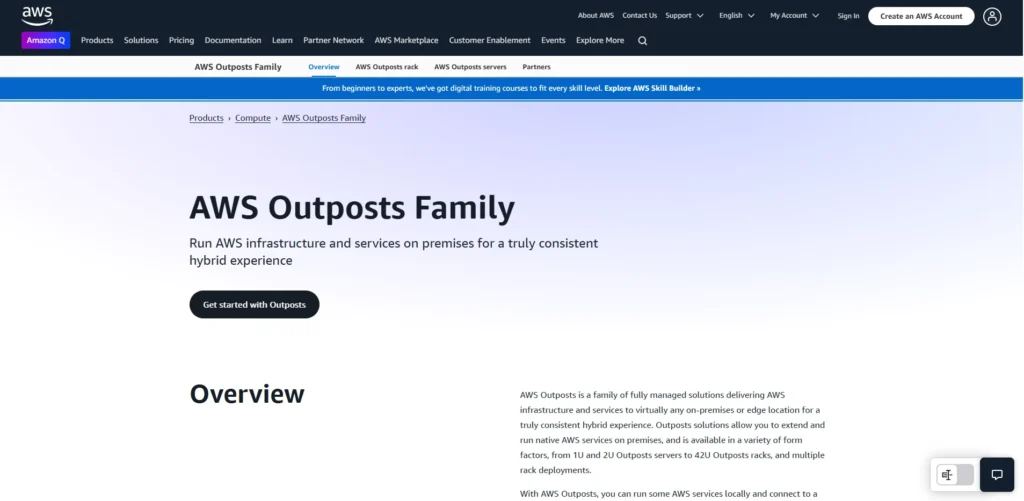
AWS Outposts brings the power of AWS cloud services directly to on-premises environments, providing a truly consistent hybrid cloud experience.
Organisations can run compute, storage, and various AWS services locally while maintaining seamless integration with AWS regions. Designed for workloads requiring ultra-low latency, data residency, or edge computing, Outposts supports services like Amazon EC2, EBS, RDS, and more.
It uses the same Application Programming Interface (APIs) and management tools as AWS cloud, offering operational uniformity. Outposts suits businesses in finance, healthcare, and manufacturing that demand cloud benefits without moving data entirely offsite.
Key Features:
- On-Prem Deployment of AWS Services: Runs native AWS infrastructure on-site.
- Unified API and Tools: Same management tools and APIs as AWS Cloud.
- Hybrid Data Storage: Integrates with Amazon S3 and EBS for hybrid storage needs.
- Custom Configuration: Available in different sizes and compute/storage combinations.
Pros:
- True Consistency: Delivers exact AWS cloud services in on-prem environments.
- Edge Computing Friendly: Excellent for ultra-low-latency applications.
- Scalable Design: Easily scales with enterprise needs.
Cons:
- High Cost: Capital and operational expenses can be significant.
- Exclusive to the AWS Ecosystem: Mostly designed with AWS users in mind.
3. Google Distributed Cloud (Anthos)
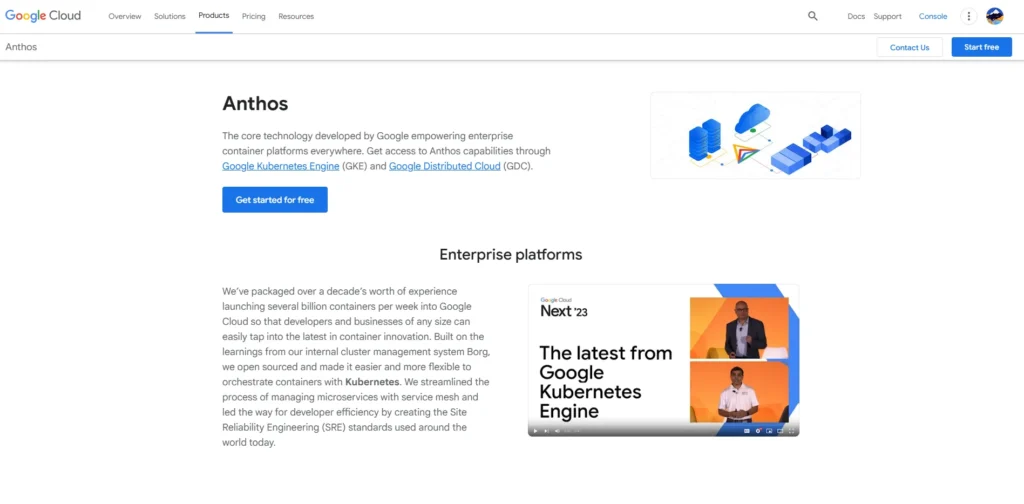
Google Distributed Cloud powered by Anthos serves as Google Cloud’s hybrid and multi-cloud platform which enables businesses to deploy and manage applications without disruption between various environments. The platform functions across on-site locations and edge points as well as other cloud management systems.
Anthos implements Kubernetes to deploy containers together with centralised policies and maintains security coherence across infrastructures. Its support for VMware alongside bare metal and Google Kubernetes Engine (GKE) enables broad deployment flexibility.
Companies that want to automate upgrades and service mesh operations and maintain infrastructure control should consider this platform. Google Distributed Cloud provides organisations the power to develop across diverse environments without forced dependency on single cloud providers.
Key Features:
- Multi-Cloud Orchestration: Manage workloads on GCP, AWS, Azure, or on-premises.
- Kubernetes Native: Built around GKE and Kubernetes for portability.
- Service Mesh & Policy Management: Includes Istio-based service mesh and unified policy.
- Edge and Telecom Support: Optimised for telco edge use cases.
Pros:
- Vendor Agnostic: Strong support for multiple cloud platforms.
- Modern DevOps Integration: Supports GitOps, CI/CD pipelines, and app modernisation.
- Rapid Innovation: Frequent updates and features from Google Cloud.
Cons:
- Learning Curve: Requires advanced understanding of Kubernetes and microservices.
- Resource Intensive: Demands significant compute and networking resources.
4. IBM Hybrid Cloud

IBM provides hybrid cloud solutions which use Red Hat OpenShift to build a single operational framework that protects developers across on-premises data centers and public as well as private clouds.
Organisations gain simplified access to deploy containerised applications through this solution which also provides consolidated tools between AI, analytics, automation and security. OpenShift enables enterprises to choose from multiple cloud vendors which provides both flexibility and freedom.
The acquisition of Red Hat created stronger hybrid cloud capabilities at IBM that allowed for advanced DevOps practices combined with microservices architecture. Identified for regulated industries, IBM provides a solution for digital transformation acceleration that maintains legacy systems and upholds strict data governance compliance standards.
Key Features:
- Enterprise Kubernetes Platform: A consistent container experience is provided by OpenShift.
- Tooling for DevSecOps: Integrated security, compliance, and automation tools.
- AI & ML Integration: Supports Watson and other IBM AI tools.
- Multi-Vendor Cloud Compatibility: OpenShift can deploy across multiple clouds.
Pros:
- Enterprise-Ready: Ideal for mission-critical enterprise workloads.
- Strong Security Posture: Built-in security, governance, and compliance support.
- Open-Source Foundation: Flexibility and extensibility with open-source tools.
Cons:
- Complex Licensing: IBM solutions may have convoluted pricing structures.
- High Learning Overhead: Requires OpenShift and Kubernetes expertise.
Suggested Read:
5. Oracle Cloud Infrastructure
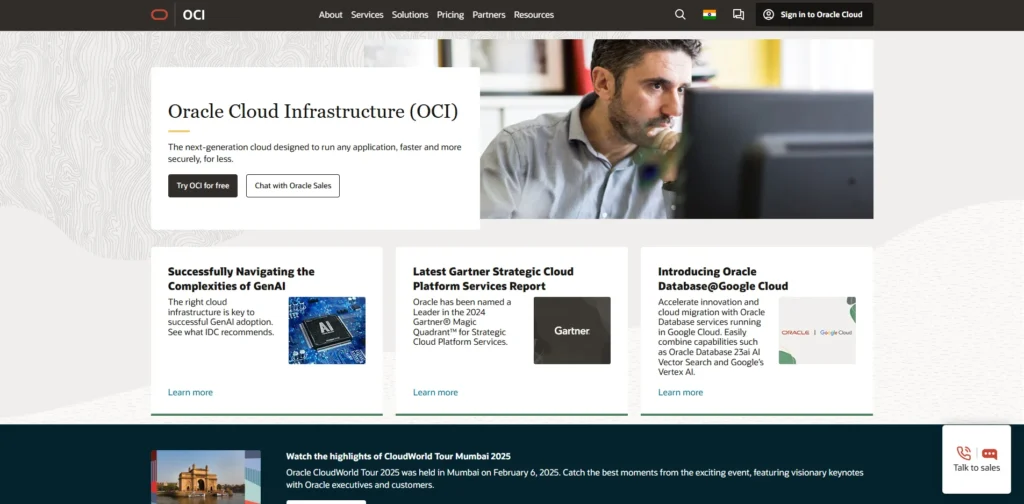
Oracle Cloud Infrastructure’s hybrid solution, Cloud@Customer, brings full Oracle cloud services directly into enterprise data centers.
It allows organisations to run Oracle’s public cloud services-compute, database, storage-on-premises, supporting data residency and latency-sensitive requirements. The platform is especially beneficial for businesses reliant on Oracle databases and applications, offering seamless integration and consistent management.
Cloud@Customer supports autonomous services, analytics, and AI while meeting regulatory and compliance needs. With consistent architecture and APIs between on-prem and public Oracle Cloud, it delivers flexibility, performance, and security for hybrid deployments in industries like finance, healthcare, and telecom.
Key Features:
- Full OCI On-Prem: Deploys Oracle’s cloud services directly in customer data centers.
- Autonomous Database: Supports Oracle’s autonomous features locally.
- High Performance Computing (HPC): Ideal for compute-heavy workloads.
- Data Residency Compliance: Helps meet stringent data localisation regulations.
Pros:
- Tight Oracle App Integration: Seamlessly supports Oracle databases and ERP apps.
- Enterprise SLA: Strong service level agreements for reliability.
- Security First Design: Integrated identity and access management.
Cons:
- Vendor Lock-In: Primarily optimised for Oracle-centric environments.
- Less Multi-Cloud Friendly: Not designed for broad multi-cloud orchestration.
6. VMware Cloud Foundation
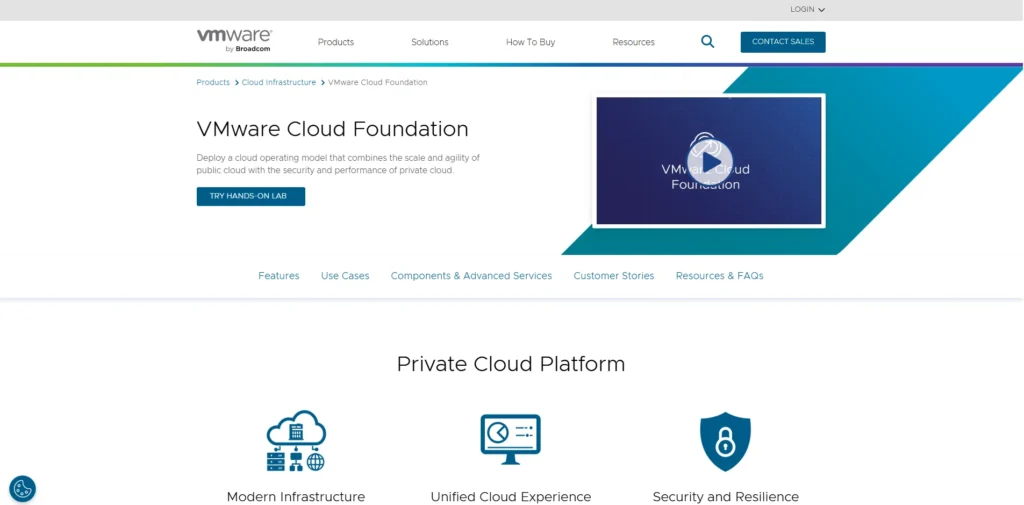
VMware Cloud Foundation works as an integrated software platform which delivers unified hybrid cloud environments through VMware technologies such as vSphere, NSX, and vSAN. Businesses can use this platform to deploy virtualized together with containerized workloads which operate across private and public clouds that extend to AWS Azure or Google Cloud.
The combination of automated provisioning features and strong security measures and built-in lifecycle management gives Cloud Foundation unprecedented capabilities to deliver efficient hybrid IT operations at scale.
Application mobility works together with disaster recovery and high availability to enable challenges across multiple clouds. Organisations using VMware’s solution can smoothly expand their VMware-held infrastructure into hybrid and multi-cloud deployments.
Key Features:
- Unified SDDC Platform: Combines vSphere, vSAN, NSX, and vRealize.
- Automated Lifecycle Management: Simplifies upgrades and patching.
- Multi-Cloud Deployments: Extends VMware environments to AWS, Azure, and GCP.
- Integrated Security: Built-in micro-segmentation and zero-trust capabilities.
Pros:
- Familiar for VMware Users: Minimises learning curve for VMware admins.
- High Workload Portability: Enables live migration between clouds.
- Flexible Deployment Models: Private cloud, public cloud, and hybrid.
Cons:
- Licensing Complexity: Multiple products bundled with varied pricing.
- Resource Heavy: Requires substantial infrastructure for full deployment.
7. Dell APEX
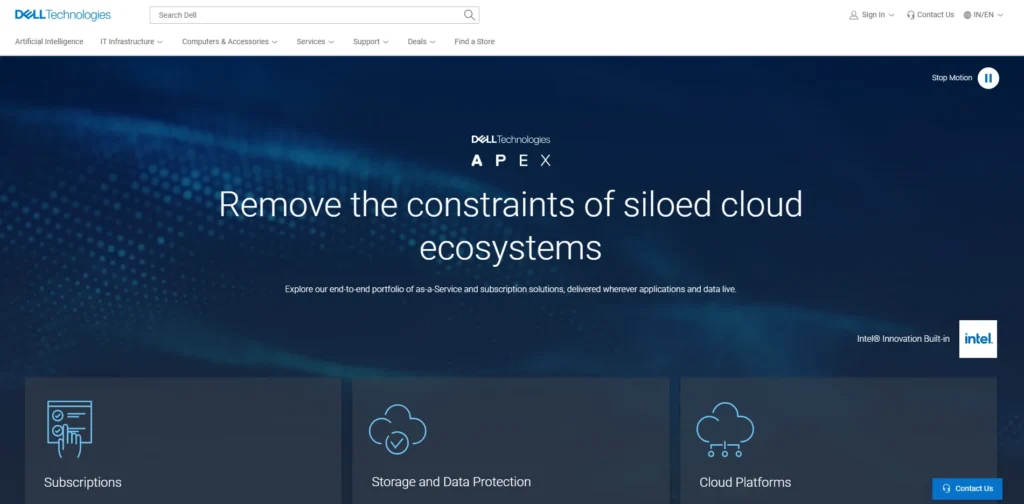
Dell APEX is a comprehensive hybrid cloud platform offering infrastructure and cloud services via a flexible as-a-service model. It enables businesses to deploy workloads in on-premises data centers with a cloud-like experience and scale seamlessly into public cloud environments.
APEX covers compute, storage, backup, and multi-cloud platforms, with deep integration into VMware Cloud and major public clouds like AWS and Azure. It simplifies IT operations through centralised management, predictable pricing, and agile provisioning.
Designed for enterprises looking to balance performance, security, and agility, Dell APEX supports digital transformation across industries while retaining control of sensitive data.
Key Features:
- Infrastructure as a Service: Provides storage, compute, backup, and data protection.
- Integration with Multiple Clouds: Links to AWS, Azure, and VMware environments.
- Centralised Management: Unified portal for deployment and monitoring.
- Flexible Consumption Models: Pay-as-you-use with customisable service levels.
Pros:
- Quick Onboarding: Quick setup made possible by automation and Dell help.
- Transition from CapEx to OpEx: Perfect for IT teams on a tight budget.
- Global Reach: Supported by Dell’s vast service and support network.
Cons:
- Primarily Infrastructure Focused: Lacks deep application-layer capabilities.
- Limited Developer Tools: Not as developer-friendly as other platforms.
8. Cisco Hybrid Cloud Platform

Cisco’s hybrid cloud platform provides a secure, scalable foundation for deploying applications across private data centers and public cloud providers. It integrates Cisco technologies such as Intersight for infrastructure management, AppDynamics for application monitoring, and ACI for network automation.
This ecosystem enhances performance visibility, operational efficiency, and policy consistency across environments. Cisco’s platform supports DevOps and cloud-native practices, making it ideal for modern application delivery.
It also emphasises zero-trust security and compliance. With compatibility across AWS, Azure, and GCP, Cisco’s hybrid solution empowers businesses to innovate while maintaining operational control and network reliability.
Key Features:
- Automated Infrastructure Management: Managed through Cisco Intersight.
- Network-Centric Architecture: Uses ACI for consistent networking.
- Application Monitoring: Integrated with AppDynamics.
- Security Integration: Supports zero-trust and workload segmentation.
Pros:
- Strong Network Optimization: Ideal for network-heavy hybrid deployments.
- End-to-End Visibility: Full stack observability across layers.
- Secure Multicloud Access: Secured connectivity between clouds and data centers.
Cons:
- Networking Expertise Required: Optimal setup requires Cisco-certified knowledge.
- Not Full Cloud-Native Stack: Less emphasis on containers and serverless tech.
9. HPE GreenLake
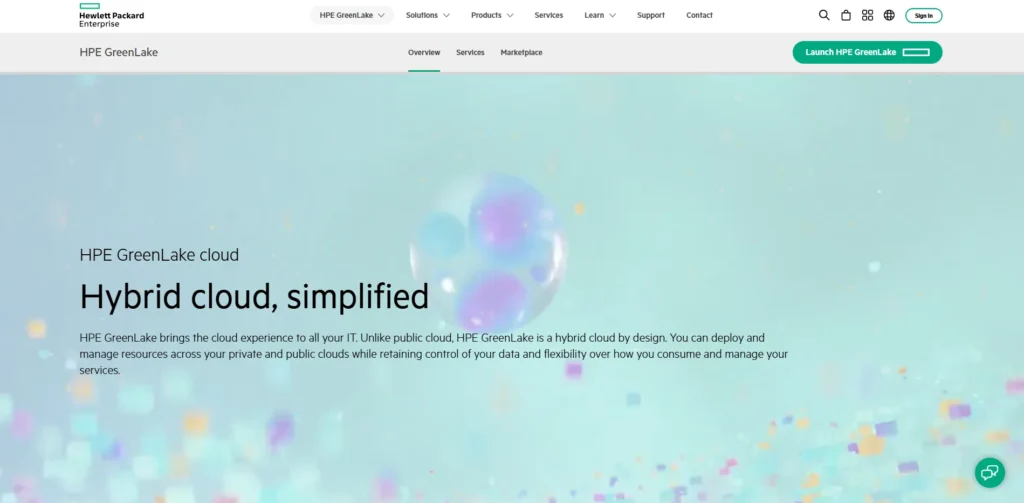
HPE GreenLake offers an edge-to-cloud platform delivering on-premises infrastructure as a service with a cloud-like experience. It allows organisations to deploy IT resources as needed, with pay-per-use pricing and centralised management.
GreenLake supports a wide range of workloads including storage, compute, container management, and AI/ML, and integrates with public clouds for hybrid capabilities. With automated scaling, security features, and real-time analytics, it’s particularly suited for enterprises prioritising performance, control, and financial transparency.
HPE GreenLake is designed to simplify IT operations, speed up deployments, and optimise cost efficiency while maintaining regulatory compliance and data locality.
Key Features:
- Consumption-Based IT: Pay-per-use on-premises infrastructure.
- Unified Cloud Console: Central platform to manage resources and usage.
- AI-Powered Operations: Leveraging HPE InfoSight for predictive analytics.
- Support for Edge to Cloud: Facilitates deployment from the data center to the edge.
Pros:
- Financial Flexibility: Reduces capital expense with operational pricing.
- High Customizability: Tailored solutions for specific workloads.
- Strong Vendor Support: Enterprise-class service and hardware support.
Cons:
- Initial Commitment Required: Often involves long-term contracts.
- Integration Complexity: Multi-cloud orchestration may require third-party tools.
10. NetApp BlueXP
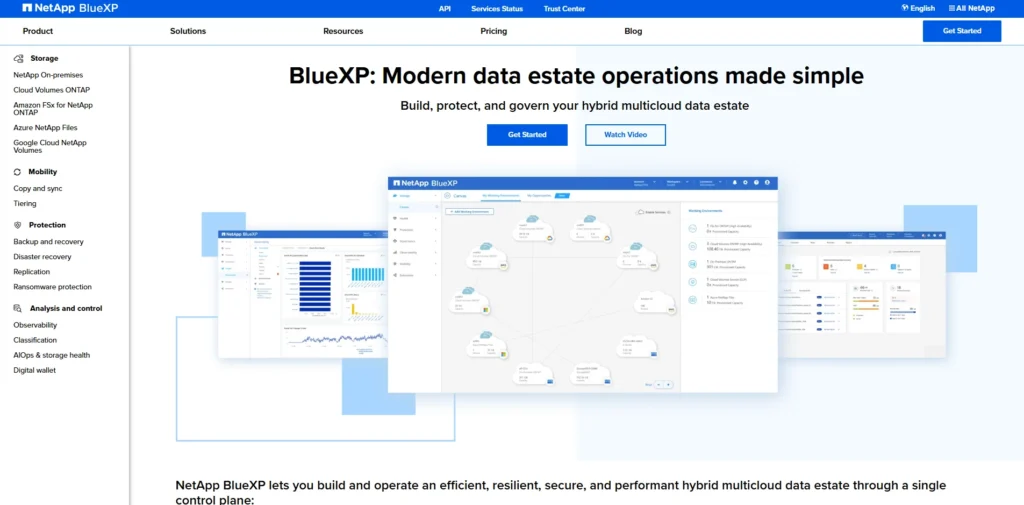
NetApp BlueXP is a comprehensive data management solution for hybrid cloud environments. It offers unified control over data storage, backup, replication, and mobility across on-premises systems and major cloud providers like AWS, Azure, and GCP.
BlueXP supports hybrid workloads with built-in analytics, security controls, and cost optimization tools. It facilitates seamless data movement, cloud bursting, and disaster recovery while reducing operational complexity.
Organisations benefit from automation, governance, and integration with Kubernetes environments. NetApp’s hybrid cloud tools are especially valuable for enterprises managing large-scale data operations and seeking agility, efficiency, and consistency across diverse IT ecosystems.
Key Features:
- Centralised Data Management: Manages data across cloud and on-premise.
- Cloud Cost Optimization: Identifies cost-saving opportunities with intelligent insights.
- Automated Backup & DR: Simplifies disaster recovery and data protection.
- Storage Tiering: Supports seamless data movement between tiers and clouds.
Pros:
- Vendor Neutrality: Works with AWS, Azure, GCP, and on-prem.
- Operational Efficiency: Simplifies storage provisioning and data migration.
- Kubernetes Integration: Supports persistent storage for containers.
Cons:
- Focuses on Storage: Not a full hybrid cloud platform-more data-centric.
- May Need Additional Tools: For full hybrid orchestration, third-party tools are required.
Conclusion
In conclusion, hybrid cloud offers a powerful, flexible, and cost-effective approach to modern IT infrastructure. By integrating the strengths of both public and private clouds, organisations can achieve optimal performance, maintain data security, and meet regulatory compliance. This model supports a wide range of use cases-from disaster recovery and application development to remote access and legacy system integration-making it ideal for businesses of all sizes and industries.
With centralised management and scalability, Hybrid Cloud Solutions enable enterprises to adapt quickly to changing demands while controlling costs. As digital transformation accelerates, adopting a hybrid cloud strategy positions organisations for long-term success, innovation, and resilience in an increasingly cloud-centric world. It’s not just a trend—it’s a strategic imperative.
FAQs
1. Why should businesses use hybrid cloud solutions?
Hybrid cloud solutions offer scalability, improved performance, cost efficiency, and enhanced security by balancing workloads across different environments.
2. How does hybrid cloud differ from multi-cloud?
Hybrid cloud integrates public and private clouds, while multi-cloud uses multiple public cloud services without necessarily connecting them to private infrastructure.
3. Are hybrid cloud solutions secure?
Yes, most hybrid cloud platforms include robust security protocols, encryption, and compliance tools to safeguard data across environments.
4. What industries benefit most from hybrid cloud solutions?
Finance, healthcare, retail, and government sectors often benefit due to their need for both agility and strict data compliance.

